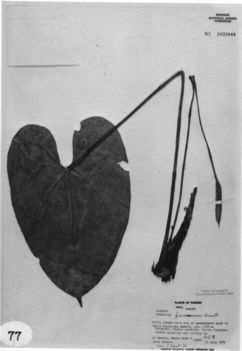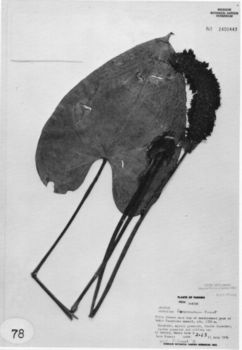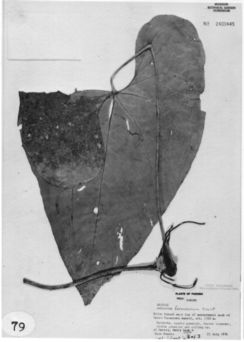



Anthurium foreroanum Croat, sp. nov.
TYPE:Panama. Darien: forest near top of westernmost peak of Cerro Tacarcuna massif (Serrania del Darien), 1,720 m. Gentry et al. 16888 (MO 2400443, holotype; COL, PMA, isotypes).
Planta epiphytica; cataphyllum coriaceum persistens intactum, petiolus teres, 34-65 cm longus, lamina sub-coriacea, ovata, basi profunde cordata, 19-39 cm lon-ga, 12-23 cm lata; pedunculus teres, 35-46 cm longus; patha alba, oblongo-lanceolata, (4-)6-8 cm longa, 1.2-2 cm lata; spadix rubrum, 4 cm aut longiore; baccae ellipsoidae, lavandulac, ca. 1 cm longae.
Epiphyte; stems 1-1.5 cm diam., internodes short near the apex, to 1 cm or more long in lower portion of stem; roots moderately few; cataphylls thick, 9-12 cm long, narrowly rounded at the apex with a short subapical apiculum, drying reddish brown and persisting intact.
LEAVES with petioles terete, 34-65 cm long, 4-6 mm diam. midway; blades subcoriaceous, ovate-cordate, gradually to abruptly acuminate at apex, deeply lobed at base, 19-39 cm long, 12-23 cm wide, broadest at the point of petiole attachment, drying thinly coriaceous, grayish green; anterior lobe 14.5-30 cm long, broadly rounded along the margins; posterior lobes 6-13 cm long (from apex of sinus to outermost point), directed toward the base; the sinus hippocrepi-form, 4÷9 cm long, rounded at apex; both surfaces semiglossy, the upper surface usually with numerous, linear raphide cells; lower surface obscurely and densely brownish speckled; midrib and basal veins raised on both surfaces; basal veins 4÷6, the first pair free or nearly so, the second pair nearly free, third to sixth coalesced 1-2.5 cm; primary lateral veins 3-5, departing midrib at 50-60° angle, weakly curved to the collective vein, drying prommulous, scarcely more prominent than the interprimary veins on drying; tertiary veins drying prominulous on both surfaces, more conspicuous below; collective vein arising from the first basal vein, usually forming an acute angle with the margin, more or less flat above, prominulous below.
INFLORESCENCE with peduncle 35-51 cm long, ca. 5 mm diam., terete, slightly shorter to longer than the petioles; spathe white to pale green, oblong-lanceolate, (4-)6-8 cm long, 1.2-2 cm wide, broadest just above base, acuminate at apex (the acumen tightly inrolled), narrowly acute and weakly decurrent at base, inserted at 45° angle on peduncle, curled in fruit; spadix red, 4÷6 cm long, 5-8 mm diam., slightly tapered to the apex; the flowers somewhat 4-lobed, 1.6-1.8 mm long, 1.8-2.3 mm wide (dried), 6-8 flowers visible in the principal spiral; tepals matte, the lateral tepals 0.9-1.1 mm wide, the inner margin broadly rounded, the outer margin 3-4-sided; stamens not seen.
INFRUCTESCENCE with lavender, ellipsoid berries, prominently beaked, ca. 1 cm long, 6 mm diam., mesocarp with numerous, dense raphide cells in apical half; seeds 1-2, ellipsoid, 3.5 mm long, 2.2 mm diam., pale green, completely enveloped in a gelatinous, transparent envelope. Figs. 77, 78,and 79.
Anthurium foreroanum is known only from the Serrania del Darien along the border of Panama and Colombia at 1,400 to 1,750 m in a lower montane wet forest life zone. It is a member of section Calomystrium and is named in honor of one of the collectors of the type, Sr. Luis Forero. The species is characterized by its ovate-cordate blades that dry matte and grayish green and have the collective vein arising from the first basal vein and then forming an acute angle with the margin and becoming rather remote from the margin near the middle of the blade. Other characteristic features include the white spathe, the reddish spadix, and the ovoid-ellipsoid, prominently beaked, lavender berries.
Anthurium foreroanum is probably most closely related to A. fraternum Schott from the Sierra Nevada de Santa Marta in northeastern Colombia near the Venezuelan border and may be only subspecifically distinct from the latter. The two species share similar leaves but the berries of A. fraternum are reddish purple to orange. The spathe of A. foreroanum is reportedly curled in fruit, whereas the spathe of A. fraternum is erect in fruit.
 |
 |
 |
Darien: vicinity Cerro Tacarcuna, Gentry & Mori 14074 (MO), Gentry et al. 16888 (COL, MO, PMA); Cerro Mali base camp, Colombian border, 1,400 m, Gentry & Mori 13764 (MO).